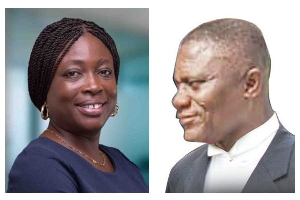 Chief State Attorney, Evelyn Keelson with Justice Aboagye Tandoh
Chief State Attorney, Evelyn Keelson with Justice Aboagye Tandoh
Mrs Genevieve Ofosuhemaa Mantey, Head of Material Science Department of the Ghana Standards Authority (GSA), says the Standards Authority does not determine the suitability of fertiliser on Cocoa plants.
She said the Authority had an office at the port and it was possible fertilisers had been analyzed and tested at their lab, but they would not know it was being tested for COCOBOD.
Mrs Mantey, a subpoenaed witness for Mr Seidu Agongo, was speaking in his evidence-in-Chief in the trial involving Dr Stephen Opuni, a former Chief Executive of COCOBOD, led by Mr Benson Nutsukpui, Counsel for Agongo.
Dr Opuni and Mr Agongo are facing 27 charges, including defrauding by false pretences, willfully causing financial loss to the State, money laundering, and corruption by a public officer in contravention of the Public Procurement Act.
They have both pleaded not guilty to the charges and are on a GH¢300,000.00 self-recognizance bail each.
She said there was no standard use of fertiliser on Cocoa at the Authority and its catalog had only three standards on fertiliser.
These standards were developed after June 2017.
She said prior to 2017, the Authority used several international standards for testing fertiliser.
The witness said K.K Amoah, a former Executive Director of EOCO, called a meeting and wanted to know why GSA produced two conflicting reports and it was the first time she had seen the Peter Papafio report.
She said during the meeting, she explained the GSA report on testing of lithovit to them and she agreed that the two reports were conflicting.
The witness told the court that from there, she was asked to write her statement and after the meeting, there was a second meeting held at Osafo Maafo Office around Ridge in Accra.
Asked whether she could remember the names of the people, who attended the meeting, the witness said she could not remember the names but said she recalled Officials from COCOBOD and two officers from the Chemistry Department of the University of Ghana and EOCO.
She said Mr Maafo at the meeting wanted to know why the reports were different and conflicting; two reports from GSA and one from the Chemistry Department.
“So, we spoke about the different methods used in the analysis and the way the sampling was done, the probable batch numbers sent to the different institutions and the environmental conditions the testing was done,” she added.
Mrs Mantey told the court that the samples were voluminous, so picking one sample was not representative enough.
She said at the meeting the analysts from GSA and the Chemistry Department also recommended that the samples could be flown outside to a credited laboratory for testing.
She said they did not give any directive concerning the confirmatory testing by the two institutions, adding that she was not aware GSA received any sample for confirmation testing.
“GSA was not contacted to conduct a confirmatory test to resolve the conflicts in the two reports,” the witness said.
The witness said there was no agreement on any standard for future testing of fertiliser in Ghana
She said the two institutions, who tested the fertiliser separately did not agree on the nutrients and elements in the sample and the sample size was different, and while the GSA received a liquid sample, the Chemistry Department received a powdery sample for the testing.